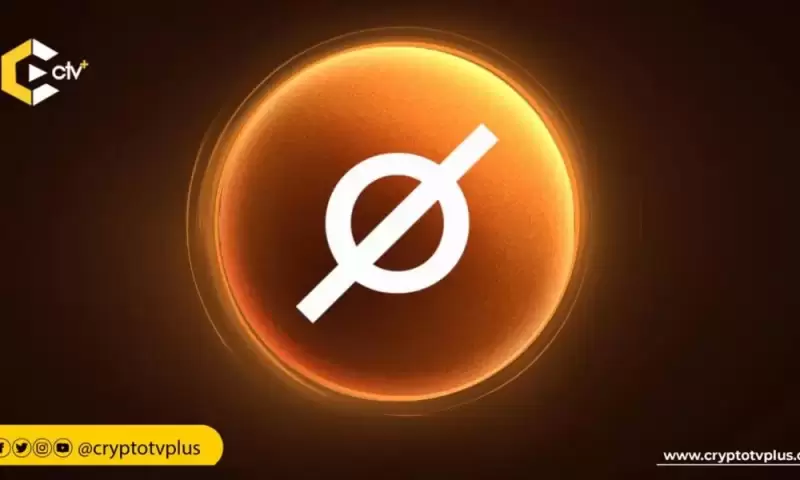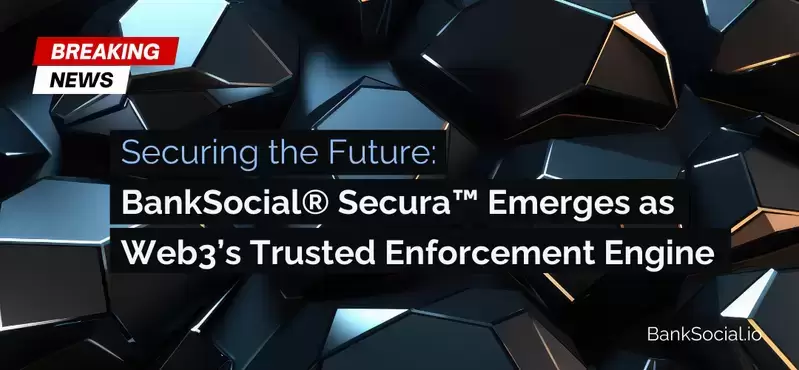 |
|
 |
|
 |
|
 |
|
 |
|
 |
|
 |
|
 |
|
 |
|
 |
|
 |
|
 |
|
 |
|
 |
|
 |
|
Solana 虛擬機器(SVM)是 Solana 區塊鏈上智慧合約的執行環境,利用平行處理模型每秒處理數千筆交易,這使得基於 Solana 構建的 dApp 能夠實現高吞吐量和低交易費用。 SVM 基於 Rust 程式語言運行,實現多執行緒事務處理模型,使網路上的驗證器能夠並發處理事務,從而提高效率和可擴展性。

What Is the Solana Virtual Machine (SVM)?
The Solana Virtual Machine (SVM) is the execution environment on the Solana blockchain, utilizing a parallel processing model for dApps that enables Solana to handle thousands of transactions per second.
什麼是 Solana 虛擬機器 (SVM)?Solana 虛擬機器 (SVM) 是 Solana 區塊鏈上的執行環境,利用 dApp 的平行處理模型,使 Solana 能夠每秒處理數千筆交易。
Key Takeaways
The Solana Virtual Machine is the execution environment for smart contracts on the Solana blockchain. It enables the Solana blockchain to handle thousands of transactions per second.
重點 Solana 虛擬機器是 Solana 區塊鏈上智慧合約的執行環境。它使 Solana 區塊鏈能夠每秒處理數千筆交易。
A virtual machine is a software emulation of a computer system that executes smart contracts within a secure environment.
虛擬機器是電腦系統的軟體模擬,可在安全環境中執行智慧合約。
Solana VM is written in Rust programming language and runs a parallel processing model for applications. According to the developers, this enables greater performance and network capacity.
Solana VM 採用 Rust 程式語言編寫,為應用程式執行平行處理模型。據開發人員稱,這可以實現更高的效能和網路容量。
This article discusses how the Solana Virtual Machine works and other key features.
本文將討論 Solana 虛擬機器的工作原理以及其他關鍵功能。
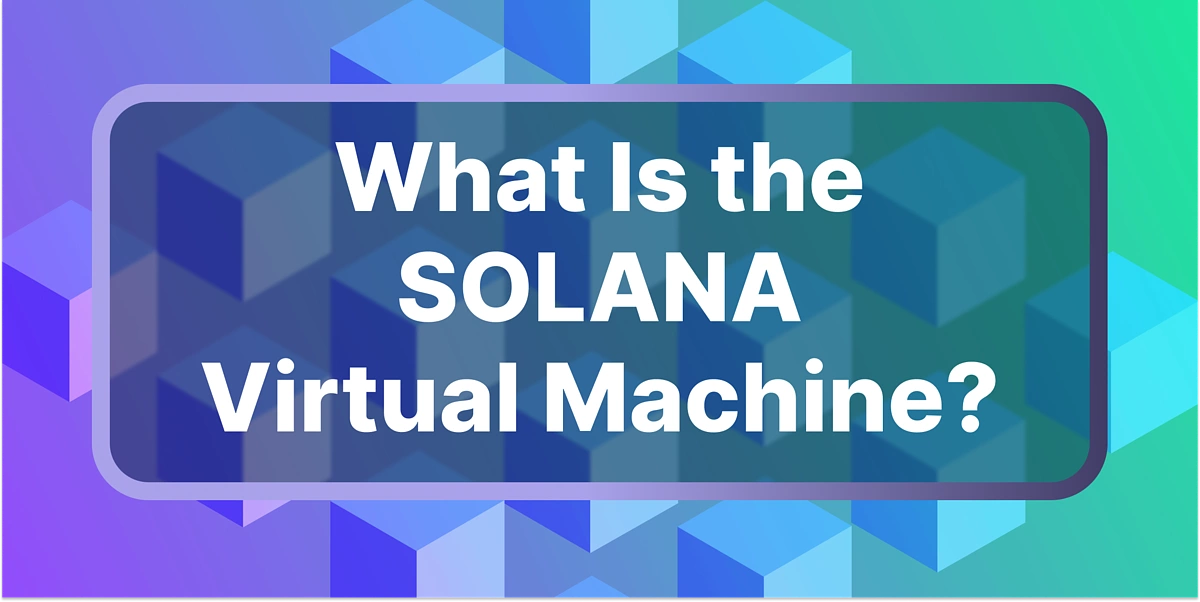
Smart contracts are a key part of the blockchain. Originally, blockchains were designed as a giant alternative payment network for one-way transactions between peers. With the creation of blockchain virtual machines (VM), it enabled smart contracts to be built on top of blockchains. From then on, the blockchain became a base layer upon which anything could be built.
智能合約是區塊鏈的關鍵部分。最初,區塊鏈被設計為一個巨大的替代支付網絡,用於點對點之間的單向交易。隨著區塊鏈虛擬機(VM)的創建,智慧合約能夠建構在區塊鏈之上。從那時起,區塊鏈成為了可以建立任何東西的基礎層。
Ethereum developed the first instance of a virtual machine for blockchain technology. The Ethereum Virtual Machine (EVM) has seen wide adoption, with popular Layer 1 blockchains such as BNB Smart Chain, Avalanche and Tron being built as a fork of the EVM, not to mention the many EVM-compatible Layer 2s being built today. Through the EVM, developers can easily port existing applications across EVM-compatible blockchains with minimal code changes.
以太坊開發了第一個用於區塊鏈技術的虛擬機器實例。以太坊虛擬機(EVM) 已被廣泛採用,流行的第1 層區塊鏈(例如BNB 智能鏈、Avalanche 和Tron)被構建為EVM 的分支,更不用說當今正在構建的許多與EVM 兼容的第2 層區塊鏈。透過 EVM,開發人員可以輕鬆地將現有應用程式移植到 EVM 相容的區塊鏈上,只需進行最少的程式碼變更。
However, the Solana Virtual Machine (SVM), one of the newest prototypes of a virtual machine built to power smart contract blockchains, is emerging as a competitor. According to developers, Solana VM was built from scratch with technologies that focus on high performance and overall agility.
然而,Solana 虛擬機 (SVM) 作為為智慧合約區塊鏈提供支援的最新虛擬機原型之一,正在成為競爭對手。根據開發人員介紹,Solana VM 是從頭開始建立的,技術專注於高效能和整體敏捷性。
Understanding the Solana Virtual Machine (SVM)
The Solana Virtual Machine handles smart contract transactions for the Solana blockchain. Built with Rust programming language, the developers claim that the SVM is adjusted for high-demand conditions and designed to handle transactions in the most efficient way. As a virtual machine, the SVM operates as a virtualized processing machine tasked with the role of handling smart contract deployment, processing transactions, and other requests from these contracts.
了解 Solana 虛擬機器 (SVM)Solana 虛擬機器處理 Solana 區塊鏈的智慧合約交易。開發人員聲稱,SVM 採用 Rust 程式語言構建,針對高需求條件進行了調整,旨在以最有效的方式處理事務。作為虛擬機,SVM 作為虛擬化處理機運行,其任務是處理智慧合約部署、處理交易以及來自這些合約的其他請求。
These transactions are state change requests, where the Solana VM computes requests and updates the overall state of the blockchain after each run. In summary, the SVM is the Solana blockchain’s execution environment. It acts in synergy with the consensus layer of the Solana blockchain to provide a dynamic network to build and run for Web3 applications.
這些事務是狀態變更請求,Solana VM 計算請求並在每次運行後更新區塊鏈的整體狀態。綜上所述,SVM 是 Solana 區塊鏈的執行環境。它與 Solana 區塊鏈的共識層協同作用,為 Web3 應用程式建置和運行提供動態網路。
The SVM supports diverse smart contract applications including GameFi, DeFi applications, and other decentralized applications. Like the EVM, Solana VM is a modular machine, where it can be deployed alongside other components, e.g. data availability / consensus layer, to build decentralized networks with little or no changes to its original form.
SVM支援多種智慧合約應用,包括GameFi、DeFi應用程式和其他去中心化應用程式。與 EVM 一樣,Solana VM 是一個模組化機器,可以與其他元件一起部署,例如資料可用性/共識層,用於建立去中心化網絡,而對其原始形式幾乎沒有任何改變。
To better understand the Solana VM, let's take a look at what a Virtual Machine actually is.
為了更能理解 Solana VM,讓我們來看看虛擬機器到底是什麼。
What Is a Virtual Machine?
Virtual machines (VMs) are a software emulation of the computer system, which can run an operating system, along with installing and executing applications. Traditionally, users ran a VM as sandbox environments that are fully isolated from their main computer operating system.
什麼是虛擬機器?虛擬機器 (VM) 是電腦系統的軟體模擬,可以運行作業系統以及安裝和執行應用程式。傳統上,使用者將虛擬機器作為沙盒環境運行,與主電腦作業系統完全隔離。
While traditional virtual machines are isolated sandboxes, blockchain virtual machines function as the execution layer of the network for decentralized applications. Blockchain VMs are decentralized, where nodes on the network run an instance of the blockchain’s virtual machine on their device, compute state changes, and monitor state changes suggested by other validators to achieve consensus, ensuring that the records of transactions are properly recorded on the network.
傳統虛擬機器是孤立的沙箱,而區塊鏈虛擬機則充當去中心化應用程式網路的執行層。區塊鏈虛擬機是去中心化的,網路上的節點在其設備上運行區塊鏈虛擬機的實例,計算狀態變化,並監視其他驗證器建議的狀態變化以達成共識,確保交易記錄正確記錄在網路上。
How the Solana Virtual Machine Works
Blockchain users are always looking for secure blockchain networks that allow them to perform transactions as fast as possible while paying the cheapest possible fees. The Solana VM was developed to satisfy the throughput desires of blockchain users and developers, while balancing the blockchain trilemma of decentralization, scalability, and security.
Solana 虛擬機的工作原理區塊鏈用戶一直在尋找安全的區塊鏈網絡,使他們能夠盡可能快地執行交易,同時支付盡可能便宜的費用。 Solana VM 的開發是為了滿足區塊鏈用戶和開發人員的吞吐量需求,同時平衡區塊鏈去中心化、可擴展性和安全性的三難困境。
At the core of the Solana VM’s operation is the parallel transaction processing model. By structuring the Solana blockchain to process multiple transactions simultaneously instead of sequentially, it can offer higher throughput while enabling scalability.
Solana VM 操作的核心是平行事務處理模型。透過建立 Solana 區塊鏈以同時而不是順序處理多個交易,它可以提供更高的吞吐量,同時實現可擴展性。
Parallel Execution with SeaLevel
SeaLevel is one of the most vital components within the Solana VM, as it allows the virtual machine to execute transactions in parallel. In contrast to the sequential execution model, the parallel transaction processing model processes transactions simultaneously by validators across the network. This allows the network to achieve higher throughput and enhanced scalability.
SeaLevel 並行執行SeaLevel 是 Solana VM 中最重要的元件之一,因為它允許虛擬機器並行執行交易。與順序執行模型相反,並行事務處理模型由網路上的驗證器同時處理事務。這使得網路能夠實現更高的吞吐量和增強的可擴展性。
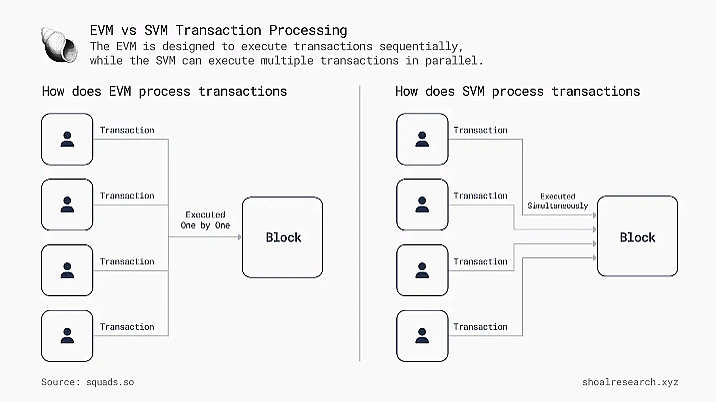
One of the challenges around parallel execution is when two transactions that change the state of the same account are executed at the same time, which could lead to errors in the final computation of the account.
並行執行的挑戰之一是當兩個改變相同帳戶狀態的交易同時執行時,這可能會導致帳戶的最終計算出現錯誤。
For example, a wallet has a 0.5 SOL balance. There are two requests: a request to send 2 SOL to the account and a request to transfer 1 SOL from the account. If the transfer request is processed before the send request, errors can occur. Let’s look at how SeaLevel handles this situation.
例如,錢包有 0.5 SOL 餘額。有兩個請求:向帳戶發送 2 SOL 的請求和從帳戶轉出 1 SOL 的請求。如果在發送請求之前處理傳輸請求,則可能會發生錯誤。讓我們看看 SeaLevel 如何處理這種情況。
With Sea Level, the Solana blockchain is able to process tons of transactions using the multiple-thread execution environment. Solana contracts are designed to be explicit in their effects, where the smart contracts state which part of the blockchain’s state is modified by each transaction. This enables the state machine to discern dependent transactions from independent transactions. Independent transactions can run without conflict since they don’t affect the same account. In the case of dependent transactions that affect the same account, they are processed in sequence to avoid conflicts.
借助 Sea Level,Solana 區塊鏈能夠使用多執行緒執行環境處理大量交易。 Solana 合約的設計目的是明確其效果,其中智能合約說明每筆交易修改了區塊鏈狀態的哪一部分。這使得狀態機能夠區分相關事務和獨立事務。獨立交易可以在沒有衝突的情況下運行,因為它們不影響同一個帳戶。如果存在影響相同帳戶的相關交易,則按順序處理這些交易以避免衝突。
The parallel transaction processing model allows the Solana blockchain to make maximum use of its resources, resulting in faster transaction processing and cheaper transaction fees. Moreover, to solve the issue of gas fee scalability faced by other virtual machines like the EVM, Solana blockchain operates a localized fee market.
平行交易處理模型使 Solana 區塊鏈能夠最大限度地利用其資源,從而實現更快的交易處理和更便宜的交易費用。此外,為了解決 EVM 等其他虛擬機器面臨的 Gas 費可擴展性問題,Solana 區塊鏈經營本地化的費用市場。
Localized Fee Market
In contrast to the global fee market, the localized fee market prevents a surge in activity from one smart contract from affecting the overall gas structure of the network.
本地化費用市場與全球費用市場不同,本地化費用市場可以防止智慧合約的活動激增影響網路的整體 Gas 結構。
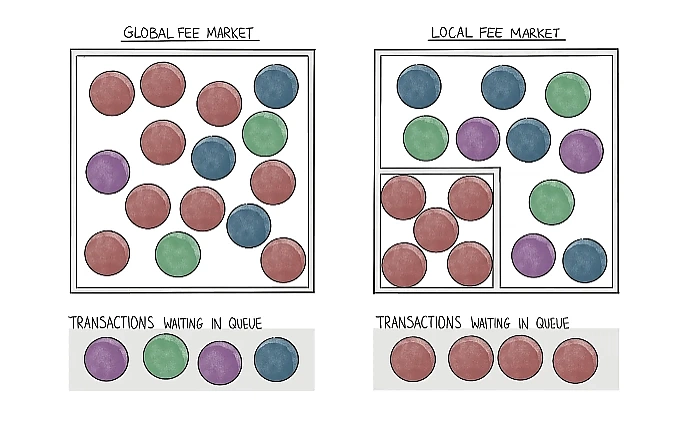
In global fee markets, the whole network jostles for the same processing facility. In a scenario where one smart contract experiences high demand, the whole network suffers from the high request frequency from this smart contract. This leads to situations where the overall network fee swells when a popular project experiences a spike in activity, for example during an NFT mint for a popular project.
資料來源:在全球費用市場中,整個網路都在爭奪同一個處理設施。當一個智能合約的需求很高時,整個網路都會受到該智能合約的高請求頻率的影響。這會導致當熱門項目的活動激增時(例如,在熱門項目的 NFT 鑄幣期間),整體網路費用會激增。
To prevent this, Solana network implements a localized fee market. With this, each smart contract on the network operates a separate processing charge structure. In case of a spike in activity, transactions from the smart contract experience a spike in gas while the rest of the network still operates on the normal gas fee rate. This limits the impact of spikes in activity from related smart contract application(s), while the rest of the network remains largely unaffected.
為了防止這種情況,Solana 網路實施了在地化費用市場。這樣,網路上的每個智能合約都運行一個單獨的處理費用結構。如果活動激增,來自智能合約的交易會經歷 Gas 激增,而網路的其餘部分仍按正常 Gas 費率運行。這限制了相關智能合約應用程式活動高峰的影響,而網路的其餘部分基本上不受影響。
However during peak demand periods, where all dApps on the network are experiencing high activity, it still increases competition for remaining blockspace, and results in higher gas fees.
然而,在需求高峰期,網路上的所有 dApp 都處於高活動狀態,這仍然會增加對剩餘區塊空間的競爭,並導致更高的 Gas 費用。
Rollup Projects Using the SVM
Due to the high performance of the Solana VM, some rollup projects are choosing the SVM for execution, while retaining the security and decentralization of the main network. Here are some rollup networks using the Solana Virtual Machine.
使用SVMD的Rollup專案由於Solana VM的高效能,一些Rollup專案選擇SVM來執行,同時保留主網路的安全性和去中心化性。以下是一些使用 Solana 虛擬機器的匯總網路。
Eclipse
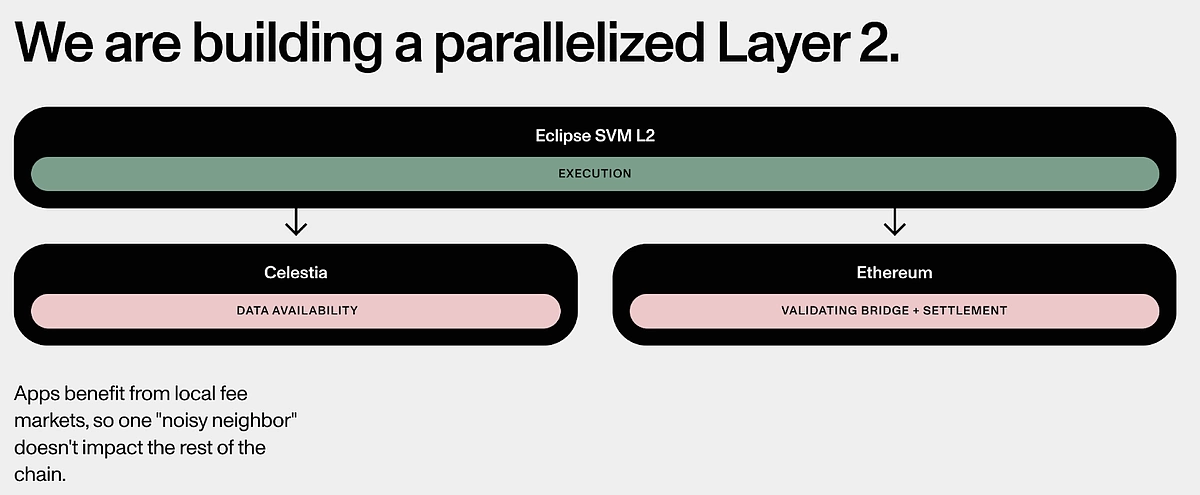
蝕
Eclipse is an EVM-compatible Layer 2 zero knowledge network built using the Solana VM. According to the project, adopting the Solana VM model to build an extremely fast rollup and settling transactions on the Ethereum network enables them to combine the best of both worlds. While the Solana VM is able to process transactions faster than the EVM, Ethereum is known to be one of the most secure and decentralized smart contract networks. Therefore, Eclipse is able to achieve an improved speed compared to other EVM Ethereum rollup networks, while maintaining Ethereum-level security and decentralization.
Eclipse 是使用 Solana VM 建構的與 EVM 相容的第 2 層零知識網路。根據該項目,採用 Solana VM 模型在以太坊網路上建立極快的總和結算交易使他們能夠結合兩個世界的優點。雖然 Solana VM 能夠比 EVM 更快地處理交易,但以太坊被認為是最安全和去中心化的智慧合約網路之一。因此,與其他 EVM 以太坊 Rollup 網路相比,Eclipse 能夠實現更高的速度,同時保持以太坊層級的安全性和去中心化。
Eclipse uses Celestia for its Data Availability (DA) layer. With Celestia, it aims to develop a stable network for the transfer of data between its execution environment and the Ethereum consensus system. It also uses RISC zero for its Zero knowledge proof computation. Using a ZK validity proof system, Eclipse hopes to achieve immediate verification for its transaction data on the mainnet. This eliminates the need for an extra fraud-proof system and a waiting interval for mainnet validation, as in the case of optimistic rollups.
Eclipse 使用 Celestia 作為其資料可用性 (DA) 層。 Celestia 的目標是開發一個穩定的網絡,用於在其執行環境和以太坊共識系統之間傳輸資料。它還使用 RISC 零進行零知識證明計算。 Eclipse希望透過ZK有效性證明系統實現其主網路交易資料的即時驗證。這消除了對額外防詐騙系統和主網驗證等待間隔的需要,就像樂觀匯總的情況一樣。
At the time of writing, Eclipse is yet to launch publicly. According to a recent announcement from the Eclipse Foundation, the project has raised a total of $65 million to advance its efforts in building an SVM L2 for the Ethereum blockchain.
截至撰寫本文時,Eclipse 尚未公開發布。根據 Eclipse 基金會最近發布的公告,該專案已籌集總計 6,500 萬美元,用於推進為以太坊區塊鏈建立 SVM L2 的工作。
MakerDAO
The MakerDAO community is on the verge of transition to a new chain for the complete reimplementation of the entire Maker Protocol built natively on a new, standalone blockchain.
MakerDAO MakerDAO 社群即將過渡到新鏈,以完全重新實現在新的獨立區塊鏈上原生建構的整個 Maker 協議。
While this is still in the community governance phase, a little information is already accessible. This includes MakerDAO co-founder Rune Christensen's preference for the Solana codebase as the prototype for the project’s new chain. In a proposal presented to the community by Rune, he cited the Solana blockchain’s resilience amidst the FTX exchange collapse and its optimization for the purpose of operating a singular, highly efficient blockchain as his major reason for picking the network’s codebase as his top choice.
雖然這仍處於社區治理階段,但已經可以獲得一些資訊。這包括 MakerDAO 聯合創始人 Rune Christensen 對 Solana 程式碼庫作為該專案新鏈原型的偏好。在Rune 向社區提交的提案中,他引用了Solana 區塊鏈在FTX 交易所崩潰中的恢復能力以及為運營單一、高效的區塊鏈而進行的優化,這是他選擇該網絡代碼庫作為首選的主要原因。
Based on the community post, Cosmos is the other main contender, with its history of successful appchains using the Cosmos stack. However, he highlights that “Cosmos is not built around efficiency at its core in the same way Solana is which means it would cost more to maintain and keep performant.”
根據社區帖子,Cosmos 是另一個主要競爭者,它擁有使用 Cosmos 堆疊的成功應用鏈的歷史。不過,他強調,“Cosmos 並不像 Solana 那樣以效率為核心,這意味著維護和保持性能的成本會更高。”
If the project finally decides to adopt the Solana network codebase as the standard for its NewChain, this will serve as a bold statement of the positive impression the Solana VM have made on blockchain projects. Reiterating his preference for the Solana Codebase, Rune mentioned that developing a blockchain network with the Solana codebase will enable Maker to benefit from the resilience of the Solana blockchain and its community. Also, MakerDAO will be able to access a large pool of developers and resources to enable it to grow faster. The network will also create a communication path with the Solana network using bridges. Read the full proposal and discussion here.
如果該專案最終決定採用 Solana 網路程式碼庫作為其 NewChain 的標準,這將是 Solana VM 給區塊鏈專案帶來的積極印象的大膽聲明。 Rune 重申了他對 Solana 程式碼庫的偏好,並提到使用 Solana 程式碼庫開發區塊鏈網路將使 Maker 能夠從 Solana 區塊鏈及其社區的彈性中受益。此外,MakerDAO 將能夠獲得大量的開發人員和資源,使其能夠更快地發展。該網路還將使用網橋創建與 Solana 網路的通訊路徑。請在此處閱讀完整的提案和討論。
SVM vs. EVM
Solana network is creating a path for itself with the Solana VM. As the SVM ecosystem grows, it will compete with the much older EVM in terms of relevance and adoption. SVM and EVM are able to handle smart contract transactions for blockchain networks. Like the EVM, the SVM is gaining application on other blockchain networks apart from the Solana Network. Here, we take a look at some of their key differences.
SVM 與 EVMSolana 網路正在使用 Solana VM 為自身建立一條路徑。隨著 SVM 生態系統的發展,它將在相關性和採用方面與更古老的 EVM 競爭。 SVM 和 EVM 能夠處理區塊鏈網路的智慧合約交易。與 EVM 一樣,SVM 正在 Solana 網路以外的其他區塊鏈網路上獲得應用。在這裡,我們來看看它們的一些主要區別。
Programming Language: Rust vs. Solidity
The Solidity programming language was developed specifically for the EVM. It is an adaptation of the JavaScript programming language and is designed for ease of learning. Like JavaScript and many other high-level programming languages, Solidity is object-oriented, where variables are declared using objects and classes. As a programming language for smart contracts and the EVM, Solidity is designed with a focus on security.
程式語言:Rust 與 Solidity Solidity 程式語言是專門為 EVM 開發的。它是 JavaScript 程式語言的改編版本,旨在易於學習。與 JavaScript 和許多其他高階程式語言一樣,Solidity 是物件導向的,其中變數是使用物件和類別聲明的。作為智慧合約和 EVM 的程式語言,Solidity 的設計重點是安全性。
In comparison, Rust is a general programming language. It can be used for smart contracts and other applications. While Rust is harder to learn, it is known for its agility and memory efficiency, along with its reputation for facilitating high performance and concurrency, which aligns with Solana’s focus on scalability.
相比之下,Rust 是一種通用程式語言。它可用於智能合約和其他應用程式。雖然 Rust 更難學習,但它以其敏捷性和記憶體效率而聞名,並以促進高效能和並發性而聞名,這與 Solana 對可擴展性的關注是一致的。
Transaction Processing Model: Parallel vs. Sequential Processing
SVM is a multi-thread transaction processing environment. It makes extensive use of the resources available on the network to process transactions. Multiple transactions are executed concurrently across different validator cores and transaction proofs are submitted for consensus as the network attains a uniform state after each run. As outlined above, Solana SeaLevel ensures that the network avoids the complications of parallel processing while running this execution model.
事務處理模型:並行處理與順序處理SVM 是一個多執行緒事務處理環境。它廣泛利用網路上可用的資源來處理交易。多個交易在不同的驗證器核心上同時執行,並且當網路在每次運行後達到統一狀態時,提交交易證明以達成共識。如上所述,Solana SeaLevel 確保網路在運行此執行模型時避免並行處理的複雜性。
Conversely, the EVM processes transactions in sequence. Multiple transactions are queued and processed one after the other. The network validates transactions using one validator core at a time. Parallel processing has shown a significantly higher throughput than sequential transaction processing models. According to reported data, the Solana blockchain can process thousands of transactions per second – this is higher than the reported speed of the Ethereum blockchain and other instances of the EVM like L2 networks and POS sidechains.
相反,EVM 按順序處理交易。多個事務依序排隊並處理。網路一次使用一個驗證器核心來驗證交易。並行處理的吞吐量明顯高於順序事務處理模型。根據報告的數據,Solana 區塊鏈每秒可以處理數千筆交易,高於以太坊區塊鏈和其他 EVM 實例(如 L2 網路和 POS 側鏈)的報告速度。
Efficiency: TPS vs. Transaction Fee
From information obtained from official network explorers, the Solana network has a transaction speed of over 2400 TPs, and transaction fees are as low as $0.001. Compared to EVM networks like Base Network with a transaction speed of about 47 TPS and a transaction fee of about $0.03, the Solana network shows a significantly higher cost and time efficiency. While this could be subject to network conditions, the Solana network can also scale to over 60,000 TPS. After the implementation of EIP-4844, Base Network’s $0.03 transaction fee is an improvement on the transaction fee on the mainnet blockchain, however, it is still short of the cost-efficiency of the Solana blockchain
效率:TPS vs. 交易費用從官方網頁瀏覽器獲得的資訊顯示,Solana 網路的交易速度超過 2400 TP,交易費用低至 0.001 美元。與 Base Network 等 EVM 網路的交易速度約為 47 TPS、交易費用約為 0.03 美元相比,Solana 網路表現出明顯更高的成本和時間效率。雖然這可能會受到網路條件的影響,但 Solana 網路也可以擴展到超過 60,000 TPS。 EIP-4844實施後,Base Network的0.03美元交易費用相對於主網區塊鏈的交易費用有所改善,但仍低於Solana區塊鏈的成本效率
Summary of SVM vs. EVM
SVM 與 EVM 的總結 | Solana VM (SVM) Solana 虛擬機器 (SVM) | Ethereum VM (EVM) 以太坊虛擬機器(EVM) |
Transaction processing 事務處理 | Multi-thread transaction processing environment 多執行緒事務處理環境 | Single-thread transaction processing environment 單線程事務處理環境 |
Data Handling 資料處理 | Solana smart contracts describe all the states a transaction will read or write while executing Solana 智能合約描述了事務在執行時將讀取或寫入的所有狀態 | Transactions are executed in sequence, eliminating the need to declare states before execution 交易按順序執行,無需在執行前聲明狀態 |
Programing language 程式設計語言 | Rust, C++ 鐵鏽、C++ | Solidity, Vyper, JavaScript Solidity、Vyper、JavaScript |
Efficiency 效率 | Process transactions faster 更快處理交易 | Relatively slower due to its single-thread model 由於其單線程模型,速度相對較慢 |
Adoption 採用 | Solana, Nitro, Eclipse Solana、硝基、Eclipse | Used by numerous sidechains, L1s, and L2 networks 被眾多側鏈、L1 和 L2 網路使用 |
Fee Market 費用市場 | Global and Localized fee market 全球和本地化費用市場 | Global Fee Market 全球費用市場 |
Final Thoughts
The Solana Virtual Machine prioritizes high throughput; a feature sought after by a big section of blockchain developers. It was built to deliver at speed and cost less than most other processing machines, which contributes immensely to the overall popularity of the Solana blockchain.
最後的想法 Solana 虛擬機器優先考慮高吞吐量;這項功能受到大部分區塊鏈開發人員的追捧。它的設計速度比大多數其他處理機器更快且成本更低,這極大地促進了 Solana 區塊鏈的整體普及。
With the Solana network now achieving success and adoption, we are seeing early adoption of the Solana VM by other projects, similar to the earlier path taken by EVM. These projects are either building directly on what has been achieved by the Solana network, or creating their own stack using other modular components.
隨著 Solana 網路現在已成功並被採用,我們看到其他專案早期採用了 Solana VM,類似於 EVM 早期採用的路徑。這些專案要麼直接建構在 Solana 網路已實現的基礎上,要麼使用其他模組化元件建立自己的堆疊。
This article attempts to give readers an understanding of what the Solana VM actually is and how it works. However, it is not exhaustive of every aspect of the Solana VM and its associated projects. Having said this, note that this article is only for educational purposes and is not financial advice. Featured projects are not endorsed, and users should always do their own research before investing in any cryptocurrency.
本文試圖讓讀者了解 Solana VM 的實際意義及其運作方式。但是,它並未詳盡介紹 Solana VM 及其相關項目的各個方面。話雖如此,請注意本文僅用於教育目的,並非財務建議。特色項目不受認可,用戶在投資任何加密貨幣之前應始終進行自己的研究。

Joel is deeply interested in the technologies behind cryptocurrencies and blockchain networks. In his over 7 years of involvement in the space, he helps startups build a stronger internet presence through written content. He is the founder of CryptocurrencyScripts.Follow the author on Twitter @agboifesinachi
CoinGecko 的內容編輯指南CoinGecko 的內容旨在揭開加密貨幣產業的神秘面紗。雖然您看到的某些帖子可能受到贊助,但我們努力維護編輯品質和誠信的最高標準,並且不會發布任何未經我們編輯審查的內容。了解更多告訴我們您有多喜歡這篇文章! Joel AgboJoel 深感對加密貨幣和區塊鏈網路背後的技術感興趣。在他涉足該領域 7 年多的時間裡,他幫助新創公司透過書面內容建立更強大的網路影響力。他是 CryptocurrencyScripts 的創始人。在 Twitter 上關注作者@agboifesinachi
閱讀更多關於喬爾·阿格博的內容
免責聲明:info@kdj.com
所提供的資訊並非交易建議。 kDJ.com對任何基於本文提供的資訊進行的投資不承擔任何責任。加密貨幣波動性較大,建議您充分研究後謹慎投資!
如果您認為本網站使用的內容侵犯了您的版權,請立即聯絡我們(info@kdj.com),我們將及時刪除。
-

- 罕見的20p硬幣帶有微小錯誤的售價超過230倍。
- 2025-04-12 09:10:14
- 一枚未註明日期的20便幣在eBay上的錘子下面,價格高達49.04英鎊。
-

- 加密市場不僅僅是趨勢,還與時機有關。
- 2025-04-12 09:10:14
- Qubetics($ TICS)已成為這次對話中最受關注的名字之一。
-

-

-

- 特朗普簽署法案,以阻止IRS Defi稅收法規
- 2025-04-12 09:00:12
- 美國國稅局設計了一項規則,該規則旨在通過將分散的加密貨幣交換為定義來重新定義什麼構成經紀人。
-

-

- #PI硬幣價格的自由度超過80%
- 2025-04-12 08:55:13
- #PI硬幣價格從過去30天的高度從2.98美元到0.4012美元中的自由落體超過80%。但是,隨著市場情緒變成看漲
-

- 直接的金色評論 - 是騙局還是合法的?
- 2025-04-12 08:55:13
- 在貿易機器人的擁擠領域中,立即的戈爾達蒂(Goldarity)以兩個顯著的優勢來區分自己。
-



























































